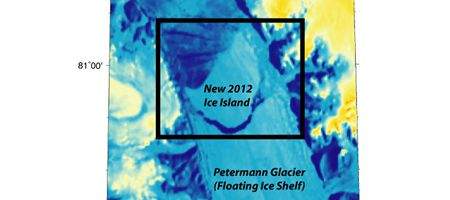The second-largest ice island in 50 years – twice the size of Manhattan – has broken away from Greenland’s Petermann Glacier.

The Petermann Glacier is one of the two largest glaciers left in Greenland connecting the great Greenland ice sheet with the ocean via a floating ice shelf.
At 46 square miles, this latest chunk is about half the size of the mega-calving that occurred from the same glacier two years ago, the largest since 1962.
“While the size is not as spectacular as it was in 2010, the fact that it follows so closely to the 2010 event brings the glacier’s terminus to a location where it has not been for at least 150 years,” says Andreas Muenchow of the University of Delaware.
“The Greenland ice sheet as a whole is shrinking, melting and reducing in size as the result of globally changing air and ocean temperatures and associated changes in circulation patterns in both the ocean and atmosphere.”
Muenchow points out that the air around northern Greenland and Ellesmere Island has warmed by about 0.11 degrees Celsius per year since 1987.
“Northwest Greenland and northeast Canada are warming more than five times faster than the rest of the world, but the observed warming is not proof that the diminishing ice shelf is caused by this, because air temperatures have little effect on this glacier,” he says.
“Ocean temperatures do, and our ocean temperature time series are only five to eight years long – too short to establish a robust warming signal.”
According to Muenchow, this newest ice island will follow the path of the 2010 ice island, moving southward until it enters Nares Strait, the deep channel between northern Greenland and Canada, where it likely will get broken up.
“This is definitely déjà vu,” Muenchow says. “The first large pieces of the 2010 calving arrived last summer on the shores of Newfoundland, but there are still many large pieces scattered all along eastern Canada from Lancaster Sound in the high Arctic to Labrador to the south.”
The Canadian Coast Guard Ship Henry Larsen is scheduled to travel to Nares Strait and Petermann Fjord later this summer to recover ocean current, temperature, salinity and ice thickness data, which may shed more light on the calving.






